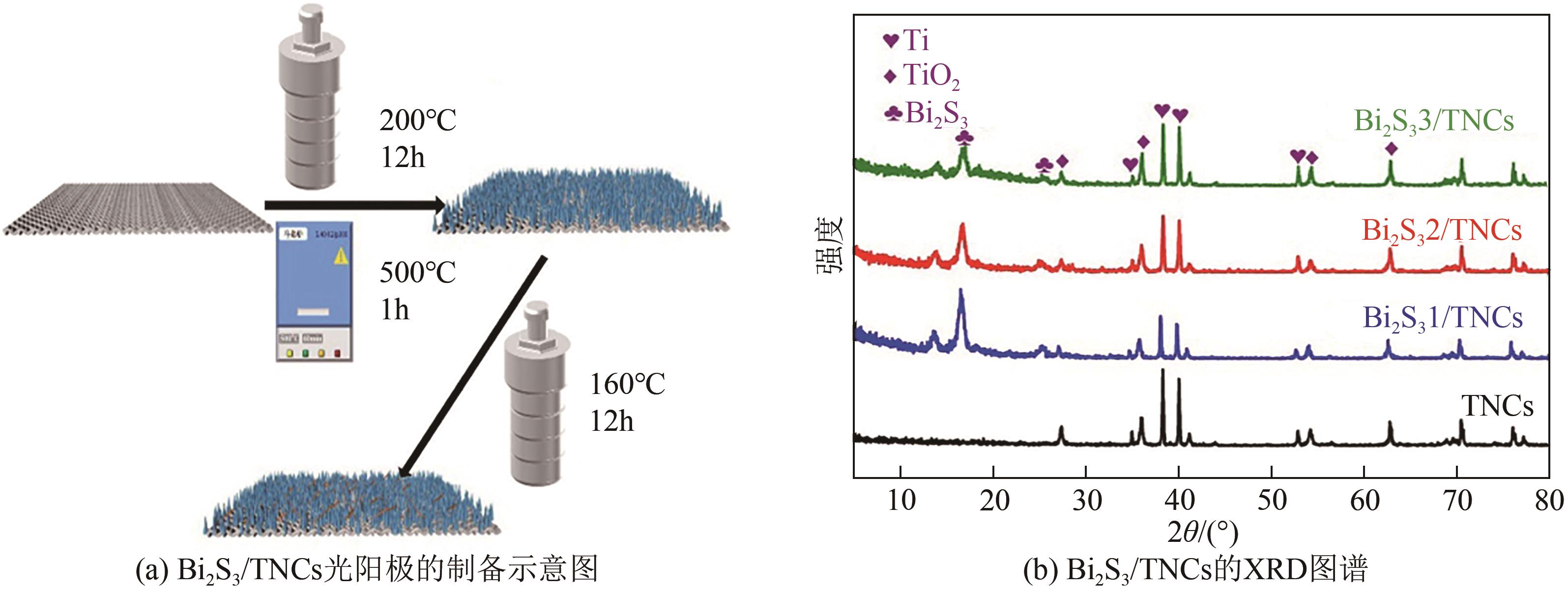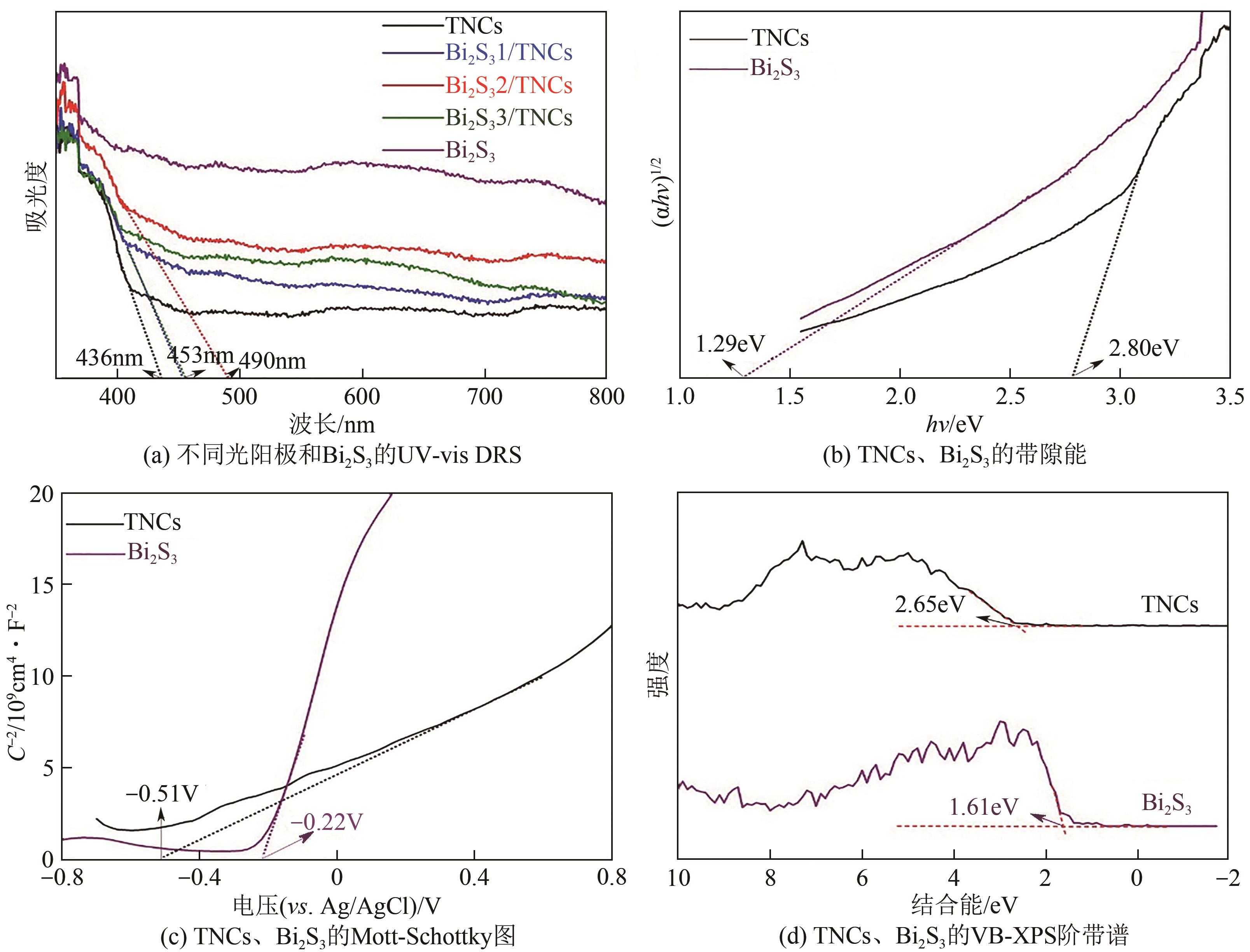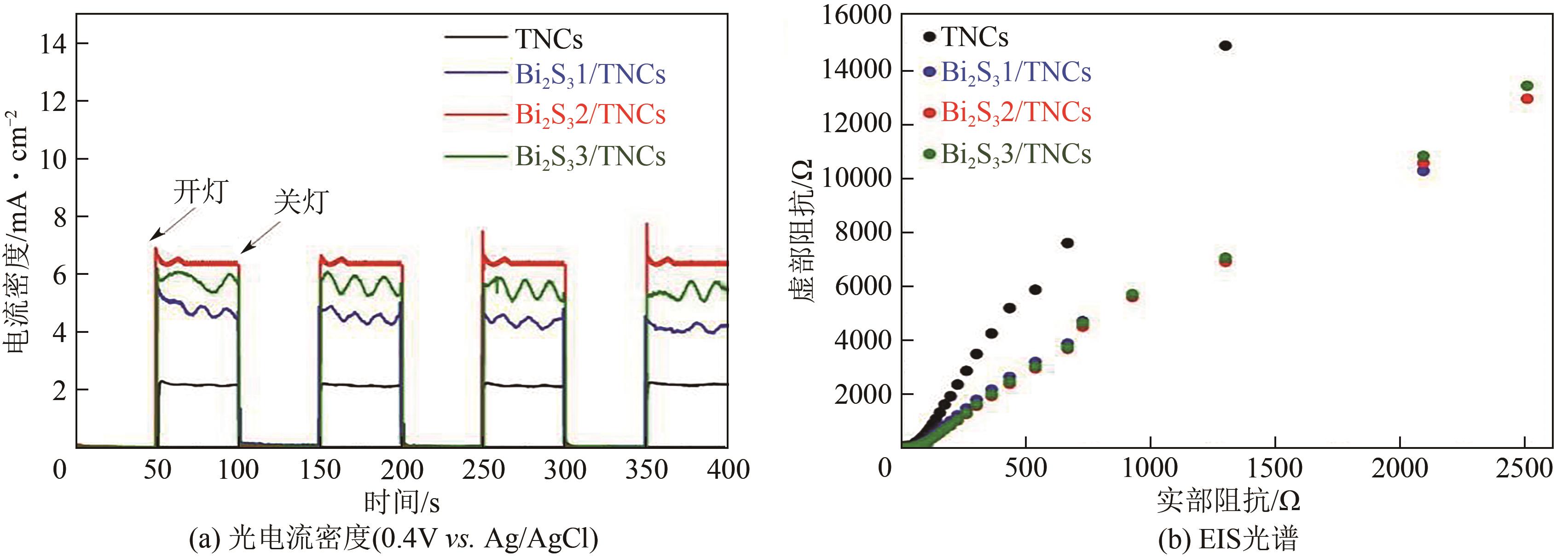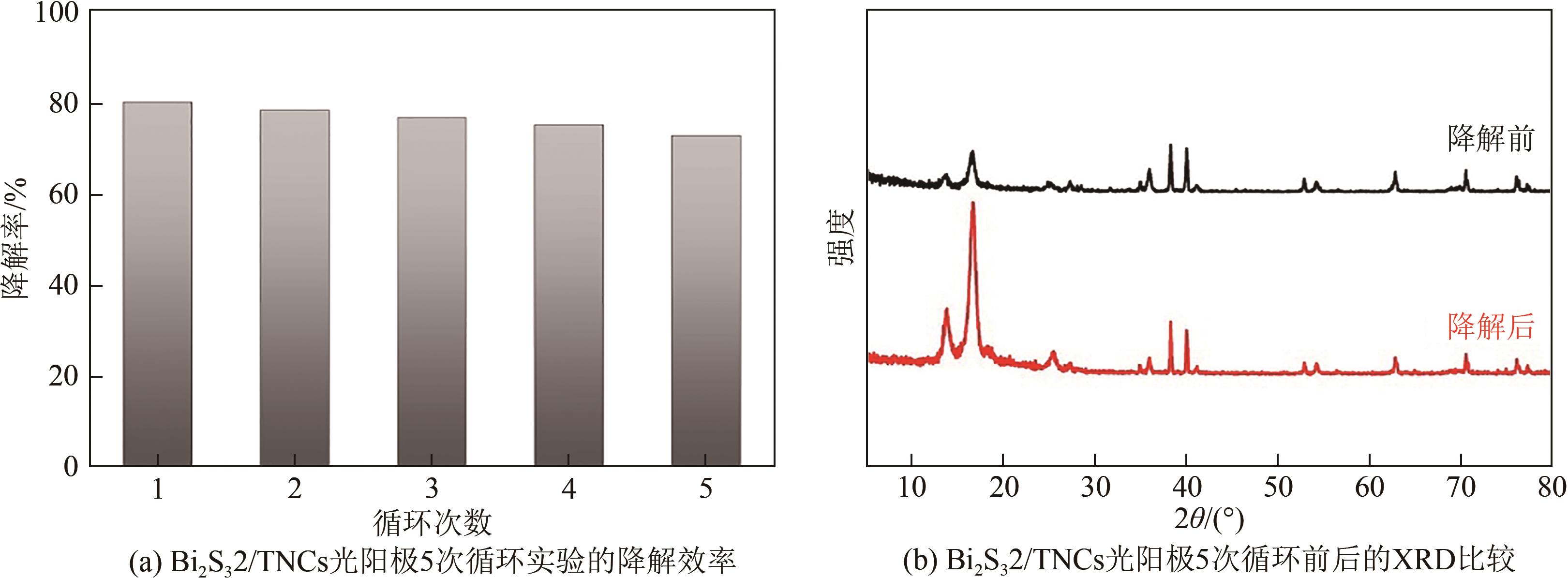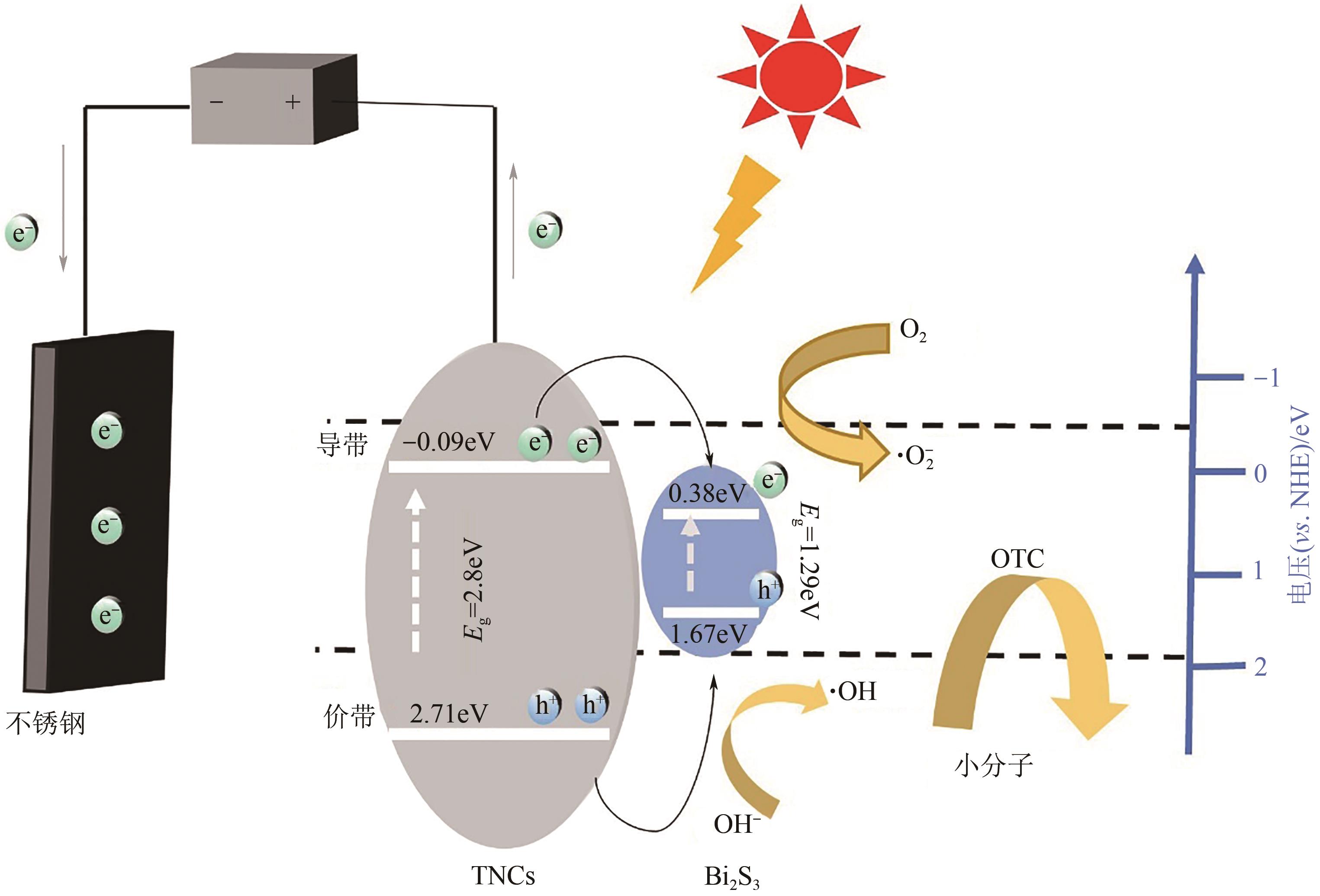化工进展 ›› 2023, Vol. 42 ›› Issue (10): 5548-5557.DOI: 10.16085/j.issn.1000-6613.2022-2111
Bi2S3/TiO2纳米锥光阳极的制备及其光电催化降解土霉素
张会霞1( ), 周立山2, 张程蕾2, 钱光磊2, 谢陈鑫2(
), 周立山2, 张程蕾2, 钱光磊2, 谢陈鑫2( ), 朱令之1(
), 朱令之1( )
)
- 1.河北工业大学化工学院,天津 300401
2.中海油天津化工研究设计院有限公司,天津 300131
-
收稿日期:2022-11-14修回日期:2023-04-21出版日期:2023-10-15发布日期:2023-11-11 -
通讯作者:谢陈鑫,朱令之 -
作者简介:张会霞(1996—),女,硕士研究生,研究方向为光电催化处理废水。E-mail:1028282574@qq.com。
Preparation of Bi2S3/TiO2 nanocone photoanode and their photoelectrocatalysis degradation of hygromycin
ZHANG Huixia1( ), ZHOU Lishan2, ZHANG Chenglei2, QIAN Guanglei2, XIE Chenxin2(
), ZHOU Lishan2, ZHANG Chenglei2, QIAN Guanglei2, XIE Chenxin2( ), ZHU Lingzhi1(
), ZHU Lingzhi1( )
)
- 1.School of Chemical Engineering, Hebei University of Technology, Tianjin 300401, China
2.CNOOC Tianjin Chemical Research and Design Institute Co. , Ltd. , Tianjin 300131, China
-
Received:2022-11-14Revised:2023-04-21Online:2023-10-15Published:2023-11-11 -
Contact:XIE Chenxin, ZHU Lingzhi
摘要:
使用两步水热法成功制备了棒状Bi2S3修饰的TiO2纳米锥(TNCs)光阳极材料,通过调节硫元素的含量探索最佳负载,并用于模拟可见光下降解土霉素。对Bi2S3/TNCs光阳极的晶型、元素价态、表面形貌和光电、电化学性能进行了详细的表征。结果表明,Bi2S3/TNCs光阳极显著提高了光电催化性能,表现出更低的电荷转移电阻,光电流密度是TNCs的3倍左右。紫外-可见分光光度计在355nm处测试结果表明,Bi2S3/TNCs光阳极在90min内成功降解了80.3%的土霉素,5次循环后仍保持良好的稳定性。此外,还对带隙能、价带谱、莫特-肖特基曲线和自由基捕获实验进行分析,提出了一种可能的光电催化降解机理。这些结果表明,Bi2S3/TNCs光阳极对降解抗生素具有很大的潜力。
中图分类号:
引用本文
张会霞, 周立山, 张程蕾, 钱光磊, 谢陈鑫, 朱令之. Bi2S3/TiO2纳米锥光阳极的制备及其光电催化降解土霉素[J]. 化工进展, 2023, 42(10): 5548-5557.
ZHANG Huixia, ZHOU Lishan, ZHANG Chenglei, QIAN Guanglei, XIE Chenxin, ZHU Lingzhi. Preparation of Bi2S3/TiO2 nanocone photoanode and their photoelectrocatalysis degradation of hygromycin[J]. Chemical Industry and Engineering Progress, 2023, 42(10): 5548-5557.
| 光阳极 | 体积/浓度 | 时间/min | 降解率/% | 参考文献 |
|---|---|---|---|---|
| Pt-N/TiO2 | 30mg/L | 60 | 56.17 | [ |
| Cu2O/α-Fe2O3 | 50mL、10mg/L | 60 | 73.3 | [ |
| ZnO/TiO2/Ag2Se | 100mL、5mg/L | 360 | 96.5 | [ |
| Bi/Bi2O3/TiO2 | 10mg/L | 300 | 76.1 | [ |
| rGO/g-C3N4/TiO2 | 80mL、40mg/L | 60 | 69.37 | [ |
| Bi2S32/TNCs | 100mL、10mg/L | 90 | 80.3 | 本工作 |
表1 不同光阳极降解土霉素
| 光阳极 | 体积/浓度 | 时间/min | 降解率/% | 参考文献 |
|---|---|---|---|---|
| Pt-N/TiO2 | 30mg/L | 60 | 56.17 | [ |
| Cu2O/α-Fe2O3 | 50mL、10mg/L | 60 | 73.3 | [ |
| ZnO/TiO2/Ag2Se | 100mL、5mg/L | 360 | 96.5 | [ |
| Bi/Bi2O3/TiO2 | 10mg/L | 300 | 76.1 | [ |
| rGO/g-C3N4/TiO2 | 80mL、40mg/L | 60 | 69.37 | [ |
| Bi2S32/TNCs | 100mL、10mg/L | 90 | 80.3 | 本工作 |
| 1 | 张延, 严晓菊, 孙越, 等. 中国抗生素滥用现状及其在环境中的分布情况[J]. 当代化工, 2019, 48(11): 2660-2662. |
| ZHANG Yan, YAN Xiaoju, SUN Yue, et al. Current situation of antibiotic abuse in China and its residues distribution in the environment[J]. Contemporary Chemical Industry, 2019, 48(11): 2660-2662. | |
| 2 | Hyejun JO, RAZA Shahbaz, FAROOQ Adeel, et al. Fish farm effluents as a source of antibiotic resistance gene dissemination on Jeju Island, South Korea[J]. Environmental Pollution, 2021, 276: 116764. |
| 3 | PAULUS Gabriela K, HORNSTRA Luc M, ALYGIZAKIS Nikiforos, et al. The impact of on-site hospital wastewater treatment on the downstream communal wastewater system in terms of antibiotics and antibiotic resistance genes[J]. International Journal of Hygiene and Environmental Health, 2019, 222(4): 635-644. |
| 4 | 李士俊, 谢文明. 污水处理厂中抗生素去除规律研究进展[J]. 环境科学与技术, 2019, 42(3): 17-29. |
| LI Shijun, XIE Wenming. Research advances in antibiotics removal in wastewater treatment plants: A review[J]. Environmental Science & Technology, 2019, 42(3): 17-29. | |
| 5 | 邵一如, 席北斗, 曹金玲, 等. 抗生素在城市污水处理系统中的分布及去除[J]. 环境科学与技术, 2013, 36(7): 85-92, 182. |
| SHAO Yiru, XI Beidou, CAO Jinling, et al. Occurrence of antibiotics and their removal mechanism in municipal sewage treatment plants[J]. Environmental Science & Technology, 2013, 36(7): 85-92, 182. | |
| 6 | 尹福斌, 詹源航, 岳彩德, 等. 膜分离技术在大型养殖场沼液处理中的应用与展望[J]. 农业环境科学学报, 2021, 40(11): 2335-2341. |
| YIN Fubin, ZHAN Yuanhang, YUE Caide, et al. Research progress on membrane technology for treatment of husbandry biogas slurry and wastewater[J]. Journal of Agro-Environment Science, 2021, 40(11): 2335-2341. | |
| 7 | ZHU Tingting, SU Zhongxian, LAI Wenxia, et al. Insights into the fate and removal of antibiotics and antibiotic resistance genes using biological wastewater treatment technology[J]. Science of the Total Environment, 2021, 776: 145906. |
| 8 | Sergi GARCIA-SEGURA, BRILLAS Enric. Applied photoelectrocatalysis on the degradation of organic pollutants in wastewaters[J]. Journal of Photochemistry and Photobiology C: Photochemistry Reviews, 2017, 31: 1-35. |
| 9 | Renato MONTENEGRO-AYO, MORALES-GOMERO Juan Carlos, ALARCON Hugo, et al. Photoelectrocatalytic degradation of 2,4-dichlorophenol in a TiO2 nanotube-coated disc flow reactor[J]. Chemosphere, 2021, 268: 129320. |
| 10 | DIVYAPRIYA G, SINGH Seema, MARTÍNEZ-HUITLE Carlos A, et al. Treatment of real wastewater by photoelectrochemical methods: An overview[J]. Chemosphere, 2021, 276: 130188. |
| 11 | LIU Dong, LI Huijun, GAO Ranpeng, et al. Enhanced visible light photoelectrocatalytic degradation of tetracycline hydrochloride by I and P co-doped TiO2 photoelectrode[J]. Journal of Hazardous Materials, 2021, 406: 124309. |
| 12 | LIANOS Panagiotis. Review of recent trends in photoelectrocatalytic conversion of solar energy to electricity and hydrogen[J]. Applied Catalysis B: Environmental, 2017, 210: 235-254. |
| 13 | LIU Yunni, LI Qian, LIAN Zichao, et al. Polarization field promoted photoelectrocatalysis for synergistic environmental remediation and H2 production[J]. Chemical Engineering Journal, 2022, 437: 135132. |
| 14 | SONG Rui, CHI Haibo, MA Qiuling, et al. Highly efficient degradation of persistent pollutants with 3D nanocone TiO2-based photoelectrocatalysis[J]. Journal of the American Chemical Society, 2021, 143(34): 13664-13674. |
| 15 | WEI Zhidong, LIU Junying, SHANGGUAN Wenfeng. A review on photocatalysis in antibiotic wastewater: Pollutant degradation and hydrogen production[J]. Chinese Journal of Catalysis, 2020, 41(10): 1440-1450. |
| 16 | 沈祥. 硫化铋纳米半导体材料的合成及其光电性质研究[D]. 长沙: 湖南大学, 2021. |
| SHEN Xiang. Synthesis and photoelectric properties of bismuth sulfide nano-semiconductor materials[D]. Changsha: Hunan University, 2021. | |
| 17 | FENG Jun, JIANG Tao, HAN Yingchun, et al. Construction of dual Z-scheme Bi2S3/Bi2O3/WO3 ternary film with enhanced visible light photoelectrocatalytic performance[J]. Applied Surface Science, 2020, 505: 144632. |
| 18 | LIU Canjun, YANG Yahui, LI Wenzhang, et al. A novel Bi2S3 nanowire @ TiO2 nanorod heterogeneous nanostructure for photoelectrochemical hydrogen generation[J]. Chemical Engineering Journal, 2016, 302: 717-724. |
| 19 | LU Yan, RADIAN Popescu, DAGMAR Gerthsen, et al. Highly efficient recovery of H2 from industrial waste by sunlight-driven photoelectrocatalysis over a ZnS/Bi2S3/ZnO photoelectrode[J]. ACS Applied Materials & Interfaces, 2022, 14(6): 7756-7767. |
| 20 | AI Changzhi, XIE Pengcheng, ZHANG Xidong, et al. Explaining the enhanced photoelectrochemical behavior of highly ordered TiO2 nanotube arrays: Anatase/rutile phase junction[J]. ACS Sustainable Chemistry & Engineering, 2019, 7(5): 5274-5282. |
| 21 | MA Hao, YUAN Chenchen, WANG Xiaomin, et al. Deposition of CeO2 on TiO2 nanorods electrode by dielectric barrier discharge plasma to enhance the photoelectrochemical performance in high chloride salt system[J]. Separation and Purification Technology, 2021, 276: 119252. |
| 22 | REN Suocai, YANG Huimin, ZHANG Dingding, et al. Excellent performance of the photoelectrocatalytic CO2 reduction to formate by Bi2S3/ZIF-8 composite[J]. Applied Surface Science, 2022, 579: 152206. |
| 23 | JIA Meiying, LIU Qi, XIONG Weiping, et al. Ti3+ self-doped TiO2 nanotubes photoelectrode decorated with Ar-Fe2O3 derived from MIL-100(Fe): Enhanced photo-electrocatalytic performance for antibiotic degradation[J]. Applied Catalysis B: Environmental, 2022, 310: 121344. |
| 24 | FENG Chengyang, DENG Yaocheng, TANG Lin, et al. Core-shell Ag2CrO4/[email protected]3N4 composites with anti-photocorrosion performance for enhanced full-spectrum-light photocatalytic activities[J]. Applied Catalysis B: Environmental, 2018, 239: 525-536. |
| 25 | LI Xibao, KANG Bangbang, DONG Fan, et al. Enhanced photocatalytic degradation and H2/H2O2 production performance of S-pCN/WO2.72 S-scheme heterojunction with appropriate surface oxygen vacancies[J]. Nano Energy, 2021, 81: 105671. |
| 26 | LIU Yazi, ZHANG Huayang, KE Jun, et al. 0D (MoS2)/2D (g-C3N4) heterojunctions in Z-scheme for enhanced photocatalytic and electrochemical hydrogen evolution[J]. Applied Catalysis B: Environmental, 2018, 228: 64-74. |
| 27 | XIE Yibing, ZHOU Limin, HUANG Chuanjun, et al. Fabrication of nickel oxide-embedded titania nanotube array for redox capacitance application[J]. Electrochimica Acta, 2008, 53(10): 3643-3649. |
| 28 | CAO Wen, YUAN Yuhang, YANG Cao, et al. In-situ fabrication of g-C3N4/MIL-68(In)-NH2 heterojunction composites with enhanced visible-light photocatalytic activity for degradation of ibuprofen[J]. Chemical Engineering Journal, 2020, 391: 123608. |
| 29 | TANG Haifang, SHANG Qian, TANG Yanhong, et al. Static and continuous flow photoelectrocatalytic treatment of antibiotic wastewater over mesh of TiO2 nanotubes implanted with g-C3N4 nanosheets[J]. Journal of Hazardous Materials, 2020, 384: 121248. |
| 30 | 张警方. CeZn/TiO2纳米管阵列光电催化降解苯并异噻唑啉酮[D]. 大连: 大连理工大学, 2020. |
| ZHANG Jingfang. Photocatalytic degradation of benzisothiazolinone by CeZn/TiO2 nanotube array[D]. Dalian: Dalian University of Technology, 2020. | |
| 31 | LI Zhaojun, QI Weining, FENG Yao, et al. Degradation mechanisms of oxytetracycline in the environment[J]. Journal of Integrative Agriculture, 2019, 18(9): 1953-1960. |
| 32 | WANG Liming, LI Mengyao, PEI Liang, et al. Pt-N co-modified TiO2 nanotube electrode photoelectrocatalytic degradation of oxytetracycline in simulated wastewater[J]. Toxics, 2022, 10(11): 635. |
| 33 | CHENG Ling, TIAN Yulu, ZHANG Jingdong. Construction of p-n heterojunction film of Cu2O/α-Fe2O3 for efficiently photoelectrocatalytic degradation of oxytetracycline[J]. Journal of Colloid and Interface Science, 2018, 526: 470-479. |
| 34 | CHANGANAQUI Katherina, BRILLAS Enric, Hugo ALARCÓN, et al. ZnO/TiO2/Ag2Se nanostructures as photoelectrocatalysts for the degradation of oxytetracycline in water[J]. Electrochimica Acta, 2020, 331: 135194. |
| 35 | QIN Jin, YE Shangshi, YAN Kai, et al. Visible light-driven photoelectrocatalysis for simultaneous removal of oxytetracycline and Cu (Ⅱ) based on plasmonic Bi/Bi2O3/TiO2 nanotubes[J]. Journal of Colloid and Interface Science, 2022, 607: 1936-1943. |
| 36 | YU Chengze, HOU Jiaqi, ZHANG Bin, et al. In-situ electrodeposition synthesis of Z-scheme rGO/g-C3N4/TNAs photoelectrodes and its degradation mechanism for oxytetracycline in dual-chamber photoelectrocatalytic system[J]. Journal of Environmental Management, 2022, 308: 114615. |
| [1] | 葛全倩, 徐迈, 梁铣, 王凤武. MOFs材料在光电催化领域应用的研究进展[J]. 化工进展, 2023, 42(9): 4692-4705. |
| [2] | 张志伟, 杨伟鑫, 张隽佶. 长波长驱动光开关染料分子研究进展[J]. 化工进展, 2023, 42(8): 4058-4075. |
| [3] | 符淑瑢, 王丽娜, 王东伟, 刘蕊, 张晓慧, 马占伟. 析氧助催化剂增强光阳极光电催化分解水性能研究进展[J]. 化工进展, 2023, 42(5): 2353-2370. |
| [4] | 多佳, 姚国栋, 王英霁, 曾旭, 金滨滨. 改性Au-TiO2光降解废水中诺氟沙星的影响[J]. 化工进展, 2023, 42(2): 624-630. |
| [5] | 刘海成, 孟无霜, 黄哲, 尤雨, 花瑞琪, 曹梦茹. WO3/BiOCl0.7I0.3光催化剂的制备及其光催化降解机理[J]. 化工进展, 2023, 42(1): 255-264. |
| [6] | 陈毓, 王佳佳, 汤琳. 漂浮型氮化碳光催化剂CNx@mEP的制备及性能[J]. 化工进展, 2022, 41(12): 6477-6488. |
| [7] | 赵文霞, 赵玉, 柴子茹, 张硕, 王世欣, 焦志杰. N2等离子体改性介孔TiO2的可见光催化性能及机理[J]. 化工进展, 2022, 41(11): 5820-5829. |
| [8] | 王艺蒙, 刘建军, 左胜利, 李抗. MoS2光电催化剂活性位点的优化和效能研究进展[J]. 化工进展, 2021, 40(7): 3747-3759. |
| [9] | 罗菊香, 程德书, 李明春, 辛梅华. 室温可见光引发聚合诱导自组装制备P2VP-b-PSt纳米材料[J]. 化工进展, 2021, 40(5): 2676-2684. |
| [10] | 符淑瑢, 张勤生, 鲁金芝, 马占伟. ZnO基光电极的构筑及其光电催化水分解性能研究进展[J]. 化工进展, 2021, 40(3): 1413-1424. |
| [11] | 李丽妹, 王梅阁, 杨秋生, 段中余. 均三嗪衍生物比色识别Cu2+及荧光识别Zn2+[J]. 化工进展, 2020, 39(8): 3287-3292. |
| [12] | 余传明, 曾圣威, 江金娥, 林雯毓, 邓翠儿, 李泳. 铜基化合物的可见光催化研究进展[J]. 化工进展, 2020, 39(6): 2411-2421. |
| [13] | 张文华,佃丽雯,陈海燕,叶文华,胡晓峰,王辉虎,常鹰,马新国,董仕节. 氧化钨(WO3)薄膜光电催化性能的改善及应用[J]. 化工进展, 2020, 39(2): 521-532. |
| [14] | 朱恩权, 马玉花, 艾尼娃·木尼热. 红磷光催化材料的研究进展[J]. 化工进展, 2019, 38(s1): 139-143. |
| [15] | 张甄,王宝冬,赵兴雷,李歌,王红妍,周佳丽,孙琦. 光电催化二氧化碳能源化利用研究进展[J]. 化工进展, 2019, 38(9): 3927-3935. |
| 阅读次数 | ||||||
|
全文 |
|
|||||
|
摘要 |
|
|||||
